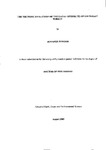THE TECTONIC EVOLUTION OF THE HATAY OPHIOLITE OF SOUTHEAST TURKEY
| dc.contributor.author | INWOOD, JENNIFER | |
| dc.contributor.other | Faculty of Science and Engineering | en_US |
| dc.date.accessioned | 2013-09-17T11:07:05Z | |
| dc.date.available | 2013-09-17T11:07:05Z | |
| dc.date.issued | 2005 | |
| dc.identifier | NOT AVAILABLE | en_US |
| dc.identifier.uri | http://hdl.handle.net/10026.1/1788 | |
| dc.description | Merged with duplicate record 10026.1/745 on 27.02.2017 by CS (TIS) | |
| dc.description.abstract |
A combination of palaeomagnetic and structural analyses have been used to constrain rotations in the Hatay (Kizildag) ophiolite of southeast Turkey in the eastern Mediterranean region and to produce a tectonic model for its evolution. The ophiolite comprises part of a prominent chain of southern Neotethyan ophiolites that stretches from the Troodos ophiolite of Cyprus eastwards to the Semail ophiolite of Oman. The Hatay ophiolite and the related Baer-Bassit ophiolite of Syria comprise the most westerly ophiolites emplaced onto the Arabian platform in the Maastrichtian. The palaeomagnetic analyses demonstrate that a large coherent anticlockwise rotation was experienced by the Hatay ophiolite, with minor variability resulting from differential rotations of adjacent tectonic blocks. Positive inclination-only tilt tests indicate that the Hatay ophiolite preserves a pre-deformational magnetisation. This is supported by rock magnetic analyses, consistent with a seafloor origin of magnetisation acquisition, soon after genesis at a spreading ridge. Magnetic carriers capable of preserving a remanence stable over geological time are identified. Palaeomagnetic analyses of the sedimentary cover sequences of the Hatay and Baer-Bassit ophiolites have been performed to provide timing constraints on the rotations in the underlying ophiolites. These illustrate that a large component of the rotations occurred pre-emplacement of the Hatay/Baer-Bassit sheet. Structural analyses performed on all levels of the Hatay ophiolite and its sedimentary cover add insight into the phases of deformation that have affected the ophiolite and enable rotations to be constrained in relation to the structural development of the ophiolite. The structural events recognised can be linked to the regional tectonic evolution of the ophiolite and used to critically evaluate previous tectonic interpretations of the Hatay ophiolite. Comparison between the large coherent anticlockwise rotations observed in the Troodos, Hatay and Baer-Bassit ophiolites imply that a significant component is likely to be linked to a common cause, inferred to be of intraoceanic origin as part of a coherent microplale. Thus, existing models for the rotation of the Troodos microplate have been revised to incorporate a larger area and also account for the rotations of the Hatay and Baer-Bassit ophiolites. Restoration of sheeted dykes to their original orientations implies that a primary variation in dyke strike existed within the southern Neotethyan ocean. In combination with the implications of the palaeomagnetic results for microplate rotation, these characteristics suggest formation of the ophiolites within a complex Neotethyan spreading system, analogous in many respects to fast-spreading marginal basin systems of the modem oceans. | en_US |
| dc.language.iso | en | en_US |
| dc.publisher | University of Plymouth | en_US |
| dc.title | THE TECTONIC EVOLUTION OF THE HATAY OPHIOLITE OF SOUTHEAST TURKEY | en_US |
| dc.type | Thesis | |
| plymouth.version | Full version | en_US |
| dc.identifier.doi | http://dx.doi.org/10.24382/4632 |
Files in this item
This item appears in the following Collection(s)
-
01 Research Theses Main Collection
Research Theses Main


